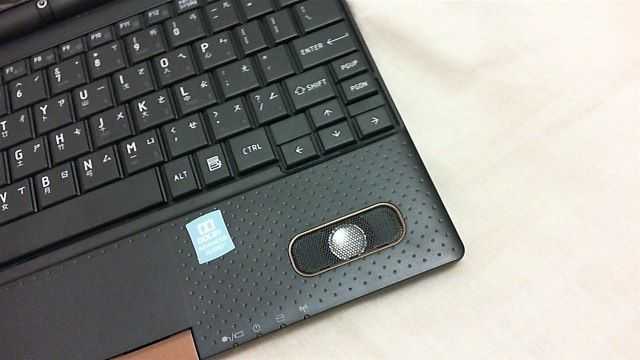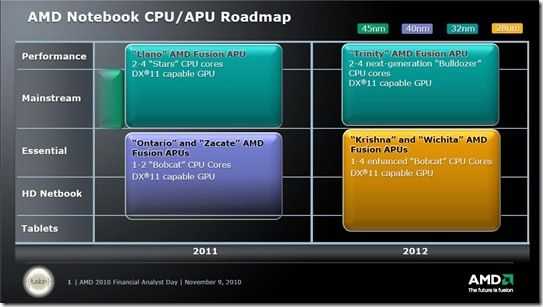Available with the C-30 or C-50 AMD Fusion platform this is the Eee PC 1015B.
Max 2GB RAM breaks the mould a bit and we suspect this could come with Windows 7 OS options unlike many 10″ Netbooks
Posted from WordPress for Android with the Galaxy Tab

One of the biggest potential changes in the netbook market is being driven by AMD who think that high quality GPU and video decoding should be included. The C-50 / Ontario ‘APU’ is the part we need to take note of in the Fusion range and Netbooknews are now providing us with one of the first English language reports of an Ontario-powered device. This is the unboxing of the Toshiba N550d with a great Harmon Kardon speakers. The benchmarks will follow.
I’ve done my own analysis based on some reports that are already out there and I think that the X86 part of the platform is going to come in at just under Atom N550 performance. The 3D and HD performance will blow the Intel netbook platform, Pinetrail, away but it will be at the expense of about 10%-20% battery life. For those wanting 3D and HD video, its a small price to pay. For those more interested in general office-style computing, the high end dual core Atoms will probably be the way to go for the 1-1.3kg range of devices.
Via Netbooknews

Are you waiting to see how that 1Ghz dual-core AMD Fusion platform benchmarks before buying your next 10 inch device? I am. As someone who’s had a netbook for nearly two years now I am probably in the same boat as millions of other people I’m looking for an upgrade. I’m not buying until i’ve assessed Fusion though which means I’m scouring the web for information every day.
I’ve seen reports on the 1.6Ghz dual-core Zacate E-Series devices but they’re not targeted at the 10 inch segment. The one that’s going up against the Atom is the Ontario series. The C-50 being the dual-core 1.0Ghz version, the C-30 the single-core 1.2Ghz version. While the latter has been benchmarked, its the C-50 that is more interesting for day-to-day work.
Background on the C-series ‘APU’s’
The Toshiba NB550D has just hit the German online channels in the last week and is showing up for around 325 Euro (lowest price.) which puts it head to head with the ASUS EeePC 1015PN (with ION graphics.) The question is, which platform has the better day-to-day performance. The two platforms has a similar total TDP but the AMD part is going to be a lot better in 3D and HD video performance. With Flash 10.1 and HTML5 canvas elements taking advantage of GPU, the AMD advantage might be more significant that it first seems for non-gamers. For gamers, the advantage is clear.
Enough of the pre-amble. What have I found?
Well we’ve got a price as mentioned above. It’s Windows Starter 7 and 1GB of RAM for the 325 Euro price which doesn’t impress me so assume a 400+ price for 2GB and Windows 7 HP. The EeePC comes in at a minimum of 429 with those specs. That’s the entry point you want to be looking at if you’re upgrading though.
Secondly, we’ve got some unboxing pics.
The unboxing comes via eprice (translation link) and there are more images available. The keyboard reminds me instantly of the one on the Toshiba AC100. That’s good. I like the look of the speakers too.
Unfortunately the author doesn’t go as far as to benchmark the device (although I’d expect it to happen soon) but there are some YouTube tests. I’m looking at the results thinking, hmmm, that’s very similar to what I saw on the Samsung N350. The 720p videos are playing with >50% CPU load.
720P video playback time when most of the water is running between 56 to 68% will go to 7X% or even to 9X% off
All I can say at the moment is that given the C-30 performance data and this YouTube performance data it’s going to be a very close match between the CPU performance of the C-50 and N550 but as I said earlier, if you get the extra 3D performance and it translates to noticeable improvements in web and UI speed, Cedar Trail is going to have to really bump up the GPU performance in order to compete. (Unless, of course, it brings in significant power savings. Intel’s Oaktrail platform indicates that it might.)
Let’s keep an eye out for more data points, and battery life figures, over the next week.

In our podcast on Monday, we spoke briefly about AMD’s ‘Atom killer.’ Coming from the ultra-mobile sector we were fairly negative about the potential impact of Fusion architecture. A comment on Carrypad made me think twice and take a closer look at the low-end of the Fusion processors (or APU’s Accelerated Processing Units- as AMD calls them) to see just what might be possible with Ontario.
I’ve seen a demo of Zacate, the dual-core 1.6Ghz version of the APU and yes, it was impressive. What demo isn’t? What was deeply imprinted on my mind though was the scary TDP of 18W. Even if that part is able to get things done and let an OS sleep faster than others, thus reducing average drain, designing around it is going to result in netbook sized devices. It’s nothing for mobile tablets.
Zacate is dual-core running at 1.6Ghz so seeing an opportunity for another part, AMD have cut down the clock and managed to reduced the design power to 9W with the Ontario part. (The overall platform is called Brazos.) We’re probably looking at 900Mhz to 1.2Ghz clock speed on a single-core here. Remember, this is a dual-core out-of-order CPU so not directly comparable with the 1.5Ghz Atom parts.
The power-envelope will be similar too. The N550 is an 8.4W part.
At this point though, it’s time to say ‘stop’ because once again, we’re talking about a netbook platform. Sure, we’ll see it in a tablet or two (it’s highly likely to be in the Acer slate) but don’t expect them to be much less than 1KG and average less than 8 to 10W drain. With the standard 30Wh battery inside this isn’t going to break new ground in terms of battery life and with battery life the #1 consideration for ultra-mobile computing, what’s the point of talking about HD decoding and GPU-accelerated HTML5?
AMD’s Zacate and Ontario will help bring competition to the netbook sector for sure and that’s a good thing. It will highlight how badly the Atom Netbook platform needs HD video decoding and a boost in 3D performance (although that is likely to be fixed in the Cedar Trail product in 2011) but it isn’t something for the ultra-mobile market. Looking at the roadmap, it looks like the 28nm ‘Wichita’ might be competition for Oaktrail with Windows but don’t expect huge leaps forward.
What the X86-based ultra mobile market needs is a change of platform AND operating system to permit always-on, ultra-low-power sleep states, high integration of Wi-Fi and 3G on new platforms. This is why ARM/Android devices are idling, connected, at 0.5W and a netbook is taking 10x that amount! It’s also why MeeGo and Oaktrail/Moorestown are being developed. Migrating away from Windows desktop support is probably the best long-term strategy there is.
Some information in this hothardware article was used in this report.
 |
| |||
 |
| |||
 |
| |||
 |
| |||
 |
| |||
 |
| |||
 |
| |||
 |
| |||
 |
| |||
 |
|